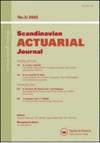Optimal reinsurance design under solvency constraints
IF 1.4
3区 经济学
Q3 MATHEMATICS, INTERDISCIPLINARY APPLICATIONS
引用次数: 0
Abstract
We consider the optimal risk transfer from an insurance company to a reinsurer. The problem formulation considered in this paper is closely connected to the optimal portfolio problem in finance, with some crucial distinctions. In particular, the insurance company's surplus is here (as is routinely the case) approximated by a Brownian motion, as opposed to the geometric Brownian motion used to model assets in finance. Furthermore, risk exposure is dialled ‘down’ via reinsurance, rather than ‘up’ via risky investments. This leads to interesting qualitative differences in the optimal designs. In this paper, using the martingale method, we derive the optimal design as a function of proportional, non-cheap reinsurance design that maximises the quadratic utility of the terminal value of the insurance surplus. We also consider several realistic constraints on the terminal value: a strict lower boundary, the probability (Value at Risk) constraint, and the expected shortfall (conditional Value at Risk) constraints under the P and Q measures, respectively. In all cases, the optimal reinsurance designs boil down to a combination of proportional protection and option-like protection (stop-loss) of the residual proportion with various deductibles. Proportions and deductibles are set such that the initial capital is fully allocated. Comparison of the optimal designs with the optimal portfolios in finance is particularly interesting. Results are illustrated.偿付能力约束下最优再保险设计
我们考虑从保险公司到再保险公司的最佳风险转移。本文考虑的问题表述与金融中的最优投资组合问题密切相关,但有一些关键的区别。特别是,保险公司的盈余在这里(通常情况下)是用布朗运动来近似的,而不是用几何布朗运动来模拟金融资产。此外,风险敞口是通过再保险“降低”,而不是通过风险投资“提高”。这导致了最优设计中有趣的质的差异。本文利用鞅方法,导出了使保险盈余终端价值的二次效用最大化的比例非廉价再保险设计函数的最优设计。我们还考虑了终端值的几个现实约束:P和Q措施下的严格下限、概率(风险值)约束和预期缺口(条件风险值)约束。在所有情况下,最优的再保险设计归结为比例保护和期权式保护(止损)的组合,剩余比例具有各种免赔额。比例和免赔额的设定使初始资本得到充分分配。最优设计与最优投资组合在金融领域的比较特别有趣。结果说明。
本文章由计算机程序翻译,如有差异,请以英文原文为准。
求助全文
约1分钟内获得全文
求助全文
来源期刊

Scandinavian Actuarial Journal
MATHEMATICS, INTERDISCIPLINARY APPLICATIONS-STATISTICS & PROBABILITY
CiteScore
3.30
自引率
11.10%
发文量
38
审稿时长
>12 weeks
期刊介绍:
Scandinavian Actuarial Journal is a journal for actuarial sciences that deals, in theory and application, with mathematical methods for insurance and related matters.
The bounds of actuarial mathematics are determined by the area of application rather than by uniformity of methods and techniques. Therefore, a paper of interest to Scandinavian Actuarial Journal may have its theoretical basis in probability theory, statistics, operations research, numerical analysis, computer science, demography, mathematical economics, or any other area of applied mathematics; the main criterion is that the paper should be of specific relevance to actuarial applications.
 求助内容:
求助内容: 应助结果提醒方式:
应助结果提醒方式:


